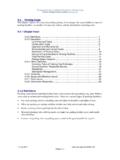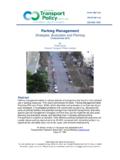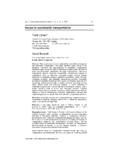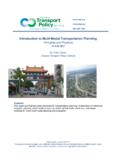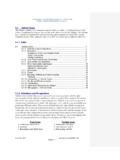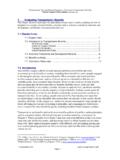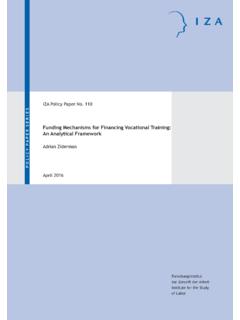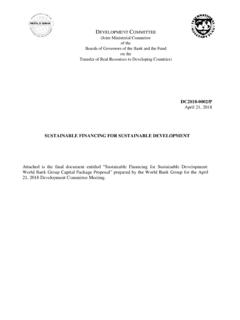Transcription of The Value Capture Approach To Stimulating Transit Oriented ...
1 Telephone: 250-360-1560 | email: The Value Capture Approach To Stimulating Transit Oriented Development And financing Transit Station Area Improvements February 2009 Thomas A. Gihring, Planning Consultant Seattle, Washington Abstract This paper examines the proposition that a land Value tax (LVT) is an effective method to promote Transit Oriented development (TOD) and raise revenue to finance public improvements within urban rail Transit station areas. A case study of a proposed TOD special assessment district in Seattle demonstrates how changing the general property tax to a LVT would provide incentives to utilize sites more intensively. The paper discusses various Value Capture mechanisms, and offers two possible land Value Capture methods to support public bond financing . This paper is an update of a published article: Applying Value Capture in the Seattle Region, Journal of Planning Practice & Research, Vol.
2 16, No. 3/4, 2001, pp. 307-320. Introduction The four-county central Puget Sound region enters the 21st century with a profusion of ambitious development plans. VISION 2040, mandated by Washington state s Growth Management Act, calls for most new growth to be contained within existing urban areas in compact communities and vibrant mixed-use centers. The Metropolitan Transportation Plan calls for a wide range of programs and joint development projects designed to integrate land use and transportation, with an emphasis on high capacity Transit . Construction is nearing completion on the first 16-mile Central Link light rail line; land acquisition and design are underway for the mile extension to University District. City and regional planners are firmly committed to the currently popular concept of TOD, that is, the creation of Transit Oriented development, or compact, mixed use activity areas centered on Transit stations that by design encourage residents, workers and shoppers to walk and to ride Transit .
3 Regional agency managers occupied with the complexities of plan implementation are coming around to the view that in addition to capital funding, regulatory and financial incentives will be needed to achieve these ambitious plans. Value Capture for Transit Oriented Development Tom Gihing 2 Transit Oriented Development Planning for compact land uses around new high volume Transit stations is a useful way to counter the effects of urban sprawl. A mix of multifamily residences with nearby shopping and neighborhood services and convenient Transit access is beneficial because it makes more efficient use of existing urban infrastructure, is convenient to residents, consumes less land, and ultimately preserves open space, farms and forests at the urban fringes. Reduced automobile dependency leads to lower household costs, and a quieter, less congested neighborhood environment.
4 The Transit -land use relationship is symbiotic, in that TOD is likely to increase Transit ridership and increase pedestrian trips - which in turn support the nodal type of commercial development (a cluster of contiguous storefronts with zero setback and minimal surface parking). It is one thing to designate TOD communities, but quite another to implement them. The re-zoning of station areas for higher density development is the most expedient regulatory mechanism available. But experience has shown that desired development will not occur simply on the basis of its classification as an allowable use. Financial inducements are needed to prompt timely development. At the same time, public planners and stakeholders need to acknowledge the fact that the announcement of station designation, the installation of station improvements, and commensurate up-zoning bring added site Value to affected properties.
5 Riley s research on London s Jubilee Line Extension revealed that a Southwark station area site was purchased in 1980 for 100,000; a year after the line s opening the site was sold for The gain was money in the bank for the owners but nothing was contributed to the welfare of the residents. Meantime, Sound Transit planners found that the original cost estimates of building the LINK system were increasing beyond expectations. Unanticipated inflationary trends in the real estate market, especially rising land prices along the designated rail corridor, drove acquisition costs beyond the project s total capital budget. Officials are now inquiring as to whether there are legal but painless ways of tapping into these escalating land values to find supplemental capital funding for the $ billion extension. The Case for Capturing Land Value Gains Implementing the region s transportation plans will require substantial public investments in new infrastructure, and sizable increases in program funding to meet TOD objectives.
6 These public sector commitments, in the form of approved detailed plans, land use regulations, and capital funding, will stimulate private sector investments in business activity and housing. This economic activity will result in the growth of land rents , or rising land values in designated locations. Such site Value increases are experienced generally, that is, independent of capital investments in building improvements that individual owners may undertake. Land rent is surplus Value , and is the product of loca-tion advantages, natural amenities, government actions, and collective private capital investments in the nearby vicinity. In the course of real estate transactions, owners and 1 Don Riley, Taken for a Ride, Centre for Land Policy Studies, UK. Value Capture for Transit Oriented Development Tom Gihing 3purchasers make investment decisions based upon their expectations of local government performance.
7 Thus, government actions coincidentally give property added Value . This surplus Value , reflected in land Value assessments, can either be retained by individual owners as a capitalized asset, or captured by the public sector to be redistributed as public benefits. Land owners typically desire to retain their property appreciation because it represents the Value conferred through ownership. However, a basic principle in liberal economic theory holds that legitimately created Value belongs to the creator of that Value . Hence, government in its role as steward of publicly created Value is justified in collecting what the community has given. A benefits received view of just taxation means that in practical terms a part of this surplus Value needs to revert back into public infrastructure; the remainder might be retained by owners as unearned increment. 2 In practical terms, public jurisdictions have the legitimate right to recapture incremental land Value increases, either through property taxation, or set-asides requiring developers to make direct contributions to a prescribed public purpose such as the provision of below market rate dwellings.
8 Improvement Value , on the other hand, is the remaining component of property assessments and is attributable to private capital investment in individual parcels. Owners have the intrinsic right to retain most of the building Value which they themselves have created. Land Value Taxation A tax on land values produces economic and social consequences very different from a tax on Any tax tends to diminish the base upon which it is levied. Hence, what in the public s interest is desirable should be taxed less commerce, job growth and investment. What is undesirable should be taxed more pollution, traffic congestion, land consumption (urban sprawl), and energy resource depletion. Yet, as the nation s tax codes demonstrate, the reverse is often the case. Our tax system is brilliant in its perver-sity, claims green tax advocate Alan Durning, of Northwest Environmental Because buildings comprise most of the aggregate Value in real estate, the prevailing equal tax rate on land and improvements places a relatively high burden on improvement values the capital investment of owners.
9 In this way the current tax system discourages private investments in areas where property values are rising. In fact, the system amounts to an inducement to monopolize and speculate on land, that is, to hold onto property without improving or selling it, thus reaping windfall gains as land prices rise. How can these tax incentives be reversed so as to encourage new private investment in mixed-use centers and Transit - Oriented communities? 2 Fred Harrison (2006), Wheels of Fortune: Self-funding Infrastructure and the Free Market Case for a Land Tax, Institute of Economic Affairs, London. 3 Francis K. Peddle (1994), Cities and Greed, Canadian Research Committee on Taxation (Ottawa) 4 Alan Durning (1998), Tax Shift, Northwest Environmental Watch ( ), ; at Value Capture for Transit Oriented Development Tom Gihing 4 The land Value tax (LVT) as a reform measure has several advantages.
10 As a result of placing a higher tax rate on land values, it would become more costly to hold onto vacant or underutilized sites. Lowering the tax rate on improvement values would engender private capital investment in building improvements. Coincidental with the reformed tax system would be a gradual trend towards infill development, as owners realize the tax benefits of making substantial capital investments. The marginal tax shift onto sites having a high ratio of land-to-building Value would effectively be capitalized into lower resale prices. Because a land Value tax is applied uniformly to all properties within a local jurisdiction (city or county), the general effect would be a restraint on rising land prices and housing prices. Finally, the LVT, being revenue-neutral, would not result in any revenue losses. Stimulating Transit Oriented Development Through Tax Incentives Faced with the realization that land speculation is likely to occur in designated station areas, regional planners are now giving thought to new incentives to encourage TOD, including the land Value tax.

